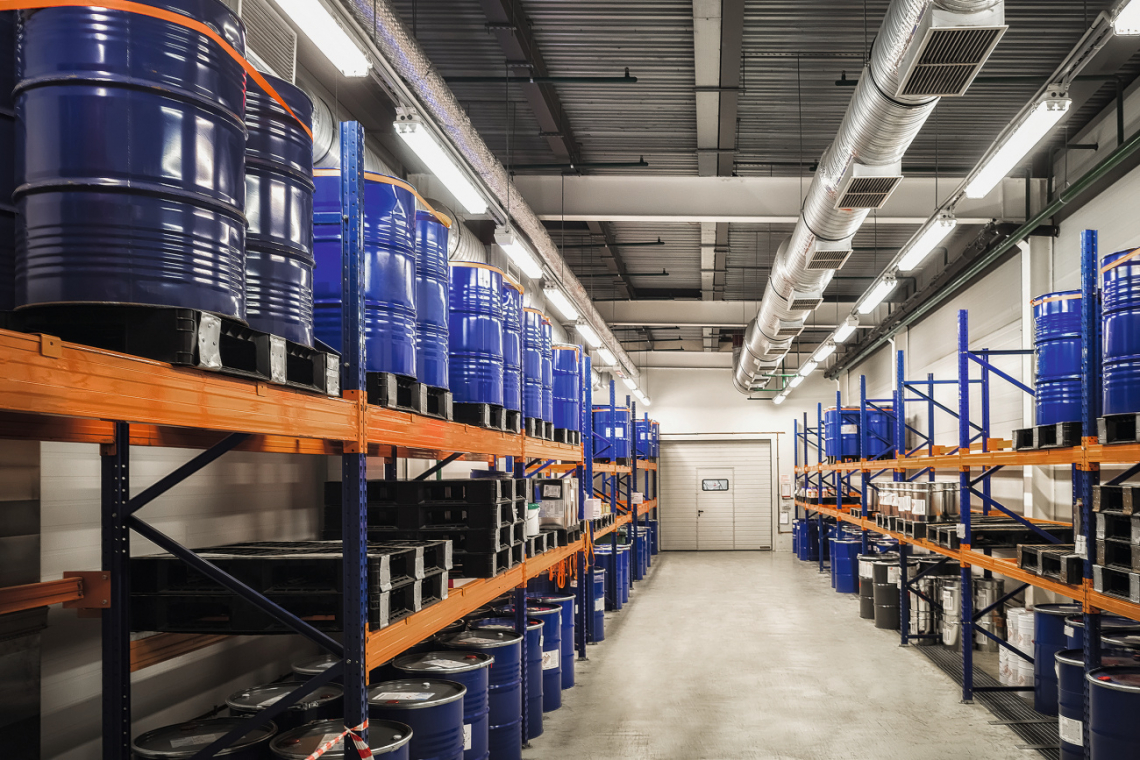Companies that require hazardous substances in their production, which undoubtedly includes electroplating shops, are faced with a number of problems: Where and how can the hazardous substances be stored in compliance with the law and, above all, safely for employees and the environment?
Of course, there are various laws and regulations governing the storage of hazardous substances. We will come back to this later in the article. Basically, there are several options for storing hazardous substances. Which is the right one for a company depends primarily on the quantity of hazardous substances, the time during which the substances must be available (access) and whether the substances are actually stored or only made available.
Storage or provision?
According to the Technical Rules for Hazardous Substances 510 (TRGS 510), provision becomes storage if the provision lasts longer than 24 hours. Or continues beyond the following working day. Conversely, hazardous substances that are processed within a working period are not subject to the statutory storage regulations. Hazardous substances that are regularly used in the workplace in very small quantities are also exempt from the storage requirements. These include, for example, lubricants or bottles with solvents or spray cans. When storing hazardous substances, a distinction is made between small quantities and quantities over 1000 or 1500 kg. As soon as the quantity of hazardous substances stored exceeds this small quantity, specific protective measures such as safety cabinets or storage rooms must be provided. Quantities below this threshold may be stored throughout the company as long as they do not block traffic routes or break rooms.
In a coating company, however, paints and varnishes, acids, alkalis and solvents are usually stored for longer periods than the 24 hours just mentioned. In this case, legally compliant storage options must be created.
Options include existing storage buildings, new storage facilities to be built, the rental of suitable storage facilities, special rooms available in the company building or mobile storage facilities such as hazardous substance cabinets.
Whichever option(s) are chosen in a company, hazardous substances must always be stored in such a way that employees and the environment are protected. Safety is therefore the top priority. For example, a hazardous materials room within the company building should have the following features:
- Adapt the structural design of walls and floors to the stored substances
- When storing flammable substances: No explosive atmosphere may arise
- Installation of ventilation systems prevents this
- Install a fire door if necessary
- Adapt the statics of the room
- Walls and ceilings in F90 design (= fire resistance class 90; required for storage of 1000 kg or more of flammable or 200 kg or more of toxic, fire-promoting hazardous substances or 20 kg of aerosols, pressurized gas packs/gas cartridges)
- If necessary, install drip trays, shelving with integrated trays, special shelves as containment systems
- Only approved systems may be used as containment systems.
If only small quantities of hazardous substances need to be stored, hazardous goods cabinets are generally used. Numerous suppliers (see short list of sources of supply) offer various protection classes. There are also regulations for such cabinets. Among other things:
- DIN EN 14470-1:2023-09 applies
- Doors and ventilation openings must close automatically
- Sump trays must be able to collect at least ten percent of the volume of all containers or at least 110 percent of the largest individual container
- Cable and pipe ducts are permitted up to 2m3
- Observe TRGS 510 and DIN EN 14727 (laboratory furniture directive)
- The cabinet must not block any transportation or escape routes.
INFO
Sources of supply *)
- Software: www.domeba.de
- Hazardous substance cabinets: www.asecos.com www.cemo.de www.denios.de www.kaiserkraft.de www.protecto.de
*) Author's note: Incomplete sample lists.
Storage of hazardous substances in practice
 When instructing employees, it is a good idea to also practice handling personal protective equipmentOf course,all potential hazards arising from the storage of hazardous substances must be identified and assessed. This is done via the risk assessment in the company, in which possible sources of danger for the employees are identified. Suitable protective measures must then be derived.
When instructing employees, it is a good idea to also practice handling personal protective equipmentOf course,all potential hazards arising from the storage of hazardous substances must be identified and assessed. This is done via the risk assessment in the company, in which possible sources of danger for the employees are identified. Suitable protective measures must then be derived.
Specifications for the storage of hazardous substances can be found in the TRGS 510 and TRGS 509 regulations. TRGS 510 specifies the storage of hazardous substances in portable containers (crates, drums). It applies equally to storage and retrieval, transportation within the warehouse and the disposal of released hazardous substances.
TRGS 509 specifies requirements for the storage of liquid or solid hazardous substances in stationary containers as well as filling and emptying points. Stationary containers include bunkers, silos and tanks. Among other things, this regulates the filling and emptying of such containers, storage together or separately and maintenance work.
Additional information can also be found in the Hazardous Substances Ordinance (GefStoffV)
Additional information can also be found in the Hazardous Substances Ordinance (GefStoffV). This stipulates, for example, that hazardous substances must be kept or stored in such a way that they do not pose a risk to the environment or human health. The employer must therefore take preventive measures to ensure that hazardous substances are not misused or mishandled.
It should also be noted that hazardous substances that are available for dispensing or immediate use must be clearly labeled in accordance with the GefStoffV. For safe handling, storage in suitable containers is also mandatory. In addition, the Water Resources Act (WHG) and the Hazardous Goods Transportation Act (GGBefG) are also relevant for the storage of hazardous substances.
Protective measures for the safe storage of hazardous substances
Preventive measures are essential to protect employees from potentially hazardous situations. The following is a selection of important guidelines:
- Employees must be instructed regularly. In this context, instructions should also be given on the correct use of necessary PPE
- The storage of hazardous substances at the workplace is only permitted in exceptional cases. Instead, they should be stored in separate rooms. Unauthorized persons have no access to hazardous substances
- Clear access regulations. Only authorized employees have access to the hazardous materials store. This group of people must be aware of the potential hazards and protective measures
- Only use containers from which hazardous substances cannot escape unintentionally. The containers must remain closed during storage
- Hazardous substances must never be stored near food. Do not set up break rooms in the vicinity of storage rooms. Hazardous substances may not be stored in stairwells, corridors or along transportation routes
- Hazardous substances, storage areas and traffic routes within the factory buildings must be clearly marked. Doors, especially emergency exits and escape routes, must be kept clear
- Storage areas must be checked regularly. Key points are tightness of storage containers, proper functioning of fire extinguishing equipment, proper ventilation, personal protective equipment. Any defects must be rectified immediately.
Further information
BAuA (2021):
TRGS 510 "Storage of hazardous substances in portable containers". Available online at https://www.baua.de/DE/Angebote/Regelwerk/TRGS/TRGS-510.html
BG RCI (2013):
Storage of hazardous substances. DGUV Information 213-084. Available online at https://downloadcenter.bgrci.de/resource/downloadcenter/downloads/M062_Gesamtdokument.pdf
VBG (2021):
Storing hazardous substances safely. Available online at https://www.vbg.de/cms/SharedDocs/Medien-Center/DE/Broschuere/Themen/Gefahrstoffe/Fachinformationsblatt_Gefahrstoffe_sicher_lagern.pdf?__blob=publicationFile&v=6
Notes on the storage of hazardous substances
The basic requirements for hazardous substance storage facilities are based on the type, quantity and classification of the substances and mixtures to be stored. As already mentioned, the quantity limit, for example, plays a decisive role in the question of whether a hazardous substance storage facility is required.
Buildings, rooms, containers or outdoor areas, for example, can be considered as storage facilities for hazardous substances.
Another important basic rule for hazardous substance storage facilities is that hazardous substances must be stored in an organized and accessible manner. All mixtures must be labeled to indicate the classification, handling risks and associated protective measures.
Safe storage is guaranteed if substances with incompatible properties are stored in separate rooms
Storing hazardous substances without a classification system is prohibited simply because dangerous and unintended reactions can occur between the substances. Certain hazardous substances must therefore not be stored together. This applies, for example, to flammable or combustible liquids in combination with oxidizing substances. Safe storage is guaranteed if substances with incompatible properties are stored in separate rooms. Safety distances in the storage areas are often insufficient.
TRGS 510 also provides clarity as to which substances must be stored together or separately and assigns hazardous substances to so-called storage classes (LGK) based on their degree of hazard. The description of the classes is based on the classifications according to the CLP Regulation and dangerous goods legislation. Accordingly, substances that belong to the same storage class can be stored together without any problems. Different classes, on the other hand, must be stored separately. Separate storage means storage in different storage sections.
The combined storage table helps to keep track of all combinations of hazardous substances when storing them together. This shows for each substance whether joint storage with the other storage classes is possible or whether joint storage is prohibited. Traffic light colors are generally used for labeling.
Digitization makes management easier
A hazardous substance register basically shows the storage location and storage quantity of certain chemicals. It is also important to know which substance properties are present. Sensible programs such as iManSys(www.domeba.de) show the user at the touch of a button which substances may be stored together or must be stored separately.
Once the hazardous substances have been assigned to the appropriate storage class, the combined storage of the classes can also be queried using the integrated combined storage table. It is also possible to check the joint storage of hazardous substances for different locations.


